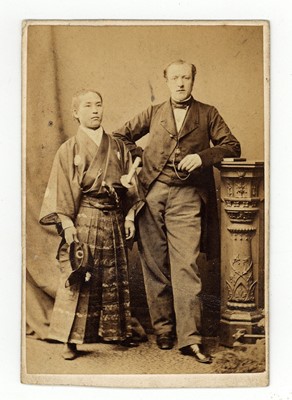12th Oct, 2022 13:00
Autographs & Memorabilia
Japanese Interest.- Enomoto Takeaki
Japanese Interest.- Enomoto Takeaki
Rare carte de visite featuring Enomoto Kamajiro (later Takeaki) in full traditional Japanese costume, standing next to J.J. van Coeverden (1829-1909), director of the Prince William of Orange Iron Foundry in The Hague, signed on the reverse by Enomoto and van Coeverden and additionally annotated in Dutch by the latter, albumen print, light soiling, 9.5 x 6.5cm, accompanied by a letter to Thomas Carswell in Glasgow, written in secretarial hand and signed by van Coeverden, saying “As a remembrance to our stay in your town I take the liberty to hand you enclosed also in the name of my fellow traveller Mr Enomoto Kamadri-roo, officer to the Japanese Navy, a photographic card. We should be obliged if receiving each also a remembrance of you by a photographic card”, one page, some creasing and folding marks, some chipping to right margin, 4to, The Hague, 23 January 1865; with another letter from van Coeverden to Carswell, reading in part “When people don’t meet within seven years, it may be very likely that they completely forget each another. I hope however, when in searching in your memory for that time, you will remember that you kindly led me through Mr Napier’s works, when I called at those Gentlemen, accompanied by my Japanese friend, Mr Enemotto”, then asking a few questions regarding pig iron from Glasgow and closing by updating Carswell on Enomoto “Our friend Enomoto has returned home some years ago to Japan and was the chief of a revolution proclaimed by the Taikoen, who had been turned out. He took some vessels, was commander of the Taikoen’s Navy but was defeated afterwards. Japanese civilisation saved him from having his stomach opened, in stead of that his antagonist the Mikado made him commander in chief of his Navy”, two pages, folding marks with minor occasional splitting, 4to, The Hague, 6 February 1873 (3)
*** Enomoto Takeaki (1836-1908) was a samurai, shogun's retainer and statesman during the end of Edo period and Meiji period. In 1856, he entered the Naval Training Center in Nagasaki, where he studied international geopolitics and seamanship. At the age of 26, Enomoto was sent to the Netherlands to study western techniques in naval warfare and to procure western technologies. He stayed in Europe from 1862 to 1867, and became fluent in both the Dutch and English languages. Upon his return, Enomoto was promoted to Kaigun Fukusōsai, the second highest rank in the Tokugawa Navy, at the age of 31. After the surrender of Edo in 1868 during the Boshin War, Enomoto refused to deliver up his warships, and escaped to Hakodate in Hokkaido with the remainder of the Tokugawa Navy in the hope to create an independent country under the rule of the Tokugawa family in Hokkaidō. The Meiji government forces invaded Hokkaidō and defeated Enomoto's forces in the Naval Battle of Hakodate. On 27 June 1869, Hokkaidō came under the rule of the central government headed by the Meiji Emperor. On January 6, 1872, Enomoto was pardoned and discharged from prison, and appointed to a post in the new government out of regard for his ability. In 1874, Enomoto was given the rank of vice-admiral in the fledgling Imperial Japanese Navy. The following year, he was sent to Russia as a special envoy to negotiate the Treaty of St. Petersburg. In 1880, Enomoto became Navy Minister.
Sold for £1,000
Includes Buyer's Premium
Do you have an item similar to the item above? If so please click the link below to submit a free online valuation request through our website.




